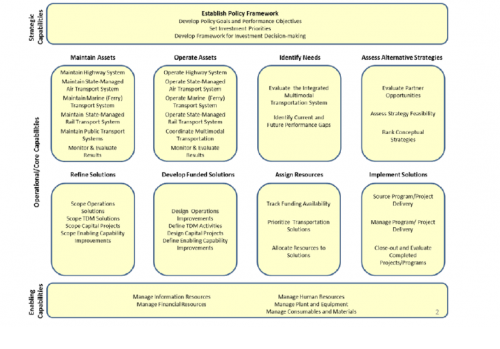In the literature, there are (at least) two views of organizational capability. The Enterprise Architecture (EA) view shown in Figure 1 defines capabilities as what an organization must do to deliver value to customers and stakeholders. In this view, Capabilities are typically segmented into strategic (or business-evolving), core, and enabling categories:
- Business-Evolving or Strategic Capabilities enable the organization to respond to change and plan for future evolution.
- Core Capabilities are related to the core operation of the agency – which in a DOT would be things like maintenance management, project delivery and highway operations.
- Enabling Capabilities support day to day operations and are common across multiple types of organizations. Examples are financial management, human resources management and information management.
A second view described in a Harvard Business Review article sees capabilities as “the collective skills, abilities, and expertise of an organization…” which are “the outcome of investments in staffing, training, compensation, communication, and other human resources areas.” In short, capabilities are defined as “the ways people and resources are brought together to accomplish work.” This article identifies 11 capabilities of well-managed companies: talent, speed, shared mindset, accountability, collaboration, learning, leadership, customer connectivity, strategic unity, innovation, and efficiency.
Figure 1.1 Enterprise Architecture View of Capabilities

Source: WSDOT Report
The EA view of capabilities provides a stable model that can be used to plan organizational improvements and relate them to value. Capabilities are aligned to some extent with functions (emphasizing what is done, not how it is done.) The HBR view is more generic, but distills the essential cross-cutting qualities that lead to success.
This guidebook incorporates a hybrid of these two models. The EA view focuses on the business evolving/strategic and supporting capabilities and provides a structure that can help agencies relate “capabilities” to their business responsibilities, while the HBR perspective emphases not just on what is delivered but the unique combination of capabilities for delivery, which can help agencies focus on strategic thinking about “capabilities” as organizational characteristics to be managed.
What do capabilities look like in the context of state DOTs and what is the evidence that demonstrates they are present? Following are several examples of capabilities and how they can be explicitly observed:
- A State DOT has a well-developed capability for innovation – they have brought in staff whose job it is to keep up with the latest developments, have a dedicated innovation group whose job it is to experiment, and have set up mechanisms to partner with the private sector and educational institutions to support research and development of cutting edge technology.
- A State DOT has high capability for leadership competency – they have established a leadership development program, they do 360 reviews, they have a mentoring program and they incorporate leadership in potential criteria in hiring.
- A State DOT has a well-developed capability for collaboration – they have aligned goals across the organization, developed a shared services model with other state and local agencies to provide administrative and procurement services and established cross-divisional teams to plan and execute system updates that integrate data across the department.
- A State DOT has a high capability for speed of implementation – they have a dedicated team of change agents, incorporate lean methods to improve process efficiency and create standard work, they coordinate automation efforts with process improvements.
Framing Capabilities
Capabilities can be expressed as:
Capability to (action/verb)
[to achieve outcome X]
What is in the brackets is the “unspoken” but important reason why this is an essential capability, and is often driven by a change force. For example.
Capability to quickly adjust strategy [to refocus on operations/maintenance]
Capability to attract and retain staff [with data science skills to address federal reporting requirements and internal needs for linking targets to investments]
Capability to innovate [to respond to rapidly-changing technology solutions, including artificial intelligence and machine learning]
Capability to manage knowledge [to eliminate the need to recreate knowledge that already exists when someone retires]
Capability to collaborate across jurisdictions and modal partners [to coordinate and collaborate with partner agencies on setting targets to make progress on performance goals]
